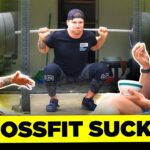In the world of resistance training, long-held views on how to build muscle strength, hypertrophy, and endurance are being re-examined.
Two pivotal studies have brought new insights that could revolutionize workout routines for fitness enthusiasts and athletes alike.
Jump to:
Key Findings Challenge Traditional Training Beliefs
“Lift to the point of exhaustion and it doesn’t matter whether the weights are heavy or light.”
Stuart Phillips, senior author on the study
Two recent studies have upended the conventional wisdom in resistance training. The first, led by Morton et al. in 2016, found that both high and low-repetition weightlifting regimens led to comparable increases in muscle mass and strength among resistance-trained men. This study notably contradicted the belief that heavier weights are necessary for maximal muscle hypertrophy.
The second study, called “Loading Recommendations for Muscle Strength, Hypertrophy, and Local Endurance“, questions a common gym idea known as the “repetition continuum.” This old idea said you need to lift heavy weights to get stronger or build bigger muscles.
But this new study says you can make your muscles strong and big using many different kinds of weights, not just heavy or light ones. It means in gym training, you have more choices with the weights you use to get strong and fit.

Implications for Muscle Strength, Hypertrophy, and Endurance
The Morton study, involving 49 men with resistance training experience, revealed that:
- Muscle gains were similar between high-repetition (HR) and low-repetition (LR) groups.
- The LR group experienced greater strength increases in bench press.
- No significant differences were observed in muscle fiber cross-sectional area increases.
- Hormonal changes post-exercise did not correlate with muscle growth or strength gains.
The “Repetition Continuum” study found that:
- Muscular strength can be developed across various loads, challenging the necessity of heavy loads for strength.
- Muscle growth is achievable across a broad range of loads, with no ideal “hypertrophy zone.”
- Evidence for a load-specific effect on muscular endurance is mixed, with weak support for the traditional repetition continuum.
Reevaluating Training Recommendations
These findings suggest a paradigm shift in how strength training is approached:
- Training programs can be more flexible, catering to individual preferences and goals.
- High-repetition training offers benefits like joint health, injury prevention, and endurance improvement.
- The findings provide a basis for more inclusive and varied workout routines, accommodating different physical capabilities and goals.
Practical Next Steps: Applying New Insights in Resistance Training

1. Incorporating CrossFit for Enhanced Metabolism and Muscle Building
- How to Implement: Blend CrossFit routines into your weekly training. These routines often combine weightlifting with high-intensity interval training (HIIT), enhancing both muscle building and metabolic rate.
- Benefits: CrossFit’s dynamic approach can help boost overall fitness, increase calorie burn, and build functional strength.
2. Using Lower Weights for Joint-Friendly Workouts
- How to Implement: Introduce sessions with lower weights and higher repetitions. Focus on maintaining good form to maximize muscle engagement.
- Benefits: This approach is especially beneficial for those with joint concerns or for older adults, as it reduces stress on the joints while still promoting muscle growth and endurance.
3. Varied Weight Training for Holistic Muscle Development
- How to Implement: Vary your weights in different sessions; some days go lighter, others heavier. This variety can address different muscle fibers and aspects of muscle development.
- Benefits: This method can lead to more comprehensive muscle development, balancing strength, size, and endurance.
4. Incorporating Bodyweight Exercises for Versatility
- How to Implement: Alongside weightlifting, include bodyweight exercises like push-ups, squats, and lunges.
- Benefits: These exercises can enhance muscular endurance and strength, and they can be done anywhere, making your routine more flexible.
References:
- https://pubmed.ncbi.nlm.nih.gov/27174923/
- https://www.ncbi.nlm.nih.gov/pmc/articles/PMC7927075/














